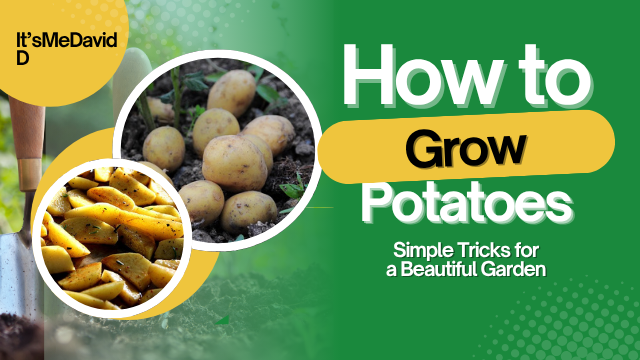
Introduction to Growing Potatoes
Growing potatoes is both rewarding and practical. Whether you’re a backyard gardener or just exploring self-sufficiency, potatoes are an excellent crop to start with. They’re rich in nutrients like potassium, fiber, and vitamin C, and incredibly versatile in the kitchen—from mash to fries.
Choosing the Right Potato Varieties
There are two main types of potato varieties:
- Determinates (early-season): These grow in a compact space and mature quickly.
- Indeterminates (late-season): These require more space but yield bigger harvests.
Best beginner varieties:
- Yukon Gold (buttery taste, good for boiling)
- Red Pontiac (great for roasting)
- Russet Burbank (classic for baking and fries)
Understanding Potato Growing Seasons
The ideal time to plant depends on your location:
| Region | Best Planting Time |
|---|---|
| Northern USA/Europe | Early to mid-spring |
| Southern USA | Late winter to early spring |
| Tropical zones | Cooler dry season |
Potatoes grow best in cool weather, ideally 45°F–75°F (7°C–24°C).
Preparing the Soil for Planting
Potatoes thrive in loamy, well-draining soil with a pH between 5.0–6.5.
Follow these steps:
- Add compost or well-rotted manure to enrich the soil.
- Test the pH and adjust if needed (add sulfur to lower it).
- Till the soil to at least 10–12 inches deep for proper root expansion.
Starting with Seed Potatoes
Don’t plant store-bought potatoes. Choose certified disease-free seed potatoes for the best start. They come pre-checked and are less prone to rot or blight.
Cut large seed potatoes into 2-inch chunks, each with at least one eye (sprout). Let the cut pieces sit for 1–2 days to “heal” and prevent rot.
Chitting Potatoes for Better Yields
Chitting means pre-sprouting your seed potatoes. Place them in an egg carton near indirect sunlight (around 60–65°F). In 2–3 weeks, you’ll see strong green shoots.
Benefits:
- Faster growth after planting
- Higher yield
Planting Methods: In-Ground, Containers, and Grow Bags
1. In-Ground Planting
- Dig trenches 6 inches deep.
- Place potatoes 12 inches apart.
- Cover lightly with soil.
2. Raised Beds and Containers
- Use 18-24 inch deep containers.
- Perfect for small spaces or patios.
3. Grow Bags (AFFILIATE PRODUCT 1)
🛒
Grow bags improve drainage, temperature control, and harvesting ease.

Spacing, Depth, and Planting Tips
- Depth: Plant 4–6 inches deep.
- Spacing: 12–15 inches apart; 30–36 inches between rows.
- Avoid planting in the same spot every year to reduce disease.
Watering and Fertilization Techniques
Potatoes need 1–2 inches of water weekly. Too much water = rot. Too little = stunted growth.
Best Fertilizer: (AFFILIATE PRODUCT 2)
🛒
Balanced N-P-K and rich in calcium and sulfur for strong tuber development.
Apply once at planting and again during flowering.
Hilling: A Crucial Step for Tuber Production
Hilling covers emerging potato stems with soil to:
- Protect tubers from sunlight (which turns them green and toxic)
- Encourage more tuber growth
Hill every 2–3 weeks or when plants grow 6–8 inches tall.
Identifying and Managing Pests and Diseases
Common Issues
- Colorado Potato Beetles
- Aphids
- Potato Blight
Use neem oil spray or row covers as prevention. Crop rotation and spacing also help reduce risk.
Harvesting Potatoes at the Right Time
- Early Varieties: 70–90 days
- Maincrop Varieties: 100–130 days
Wait until the plant tops yellow and die back. Gently dig with a fork to avoid bruising tubers.
Storing Potatoes Properly After Harvest
- Cure in a dark, dry place for 7–10 days at 60°F.
- Store in a cool, dark, well-ventilated area (40–50°F).
- Never store in the fridge—starches turn to sugar.
Easy Potato Recipes to Try at Home
🥔 Classic Mashed Potatoes
- Boil peeled Yukon Golds until soft.
- Mash with butter, milk, salt, and garlic.
🥔 Roasted Garlic Potatoes
- Cube and coat with olive oil, rosemary, and minced garlic.
- Bake at 400°F for 35 minutes.
🥔 Potato Wedges (Air Fryer Style)
🛒
- Crisp up wedges in 15 minutes with minimal oil!

Tools and Gear for Growing Potatoes
| Tool | Purpose |
|---|---|
| Grow Bags | Space-saving, breathable containers |
| Organic Fertilizer | Boost root and tuber growth |
| Hori Hori Knife | Multi-use gardening tool |
| Smart Water Timer | Ensures consistent watering |
FAQs: How to Grow Potatoes
Q1: Can I grow potatoes from store-bought ones?
Only if they’re organic and not treated to prevent sprouting. Certified seed potatoes are safer.
Q2: How long do potatoes take to grow?
Depending on variety, between 70–130 days from planting to harvest.
Q3: Can I grow potatoes indoors?
Yes, with containers and sufficient light or grow lights.
Q4: What soil is best for potatoes?
Loose, loamy soil enriched with compost and balanced pH (5.0–6.5).
Q5: Do potatoes need full sun?
Yes, at least 6–8 hours of direct sunlight daily.
Q6: Why are my potatoes green?
Exposure to sunlight creates solanine, a toxic compound. Keep them well-hilled or covered.
Conclusion and Final Tips
Growing potatoes is simple, cost-effective, and rewarding. With just a few tools like grow bags, a good organic fertilizer, and a quality air fryer, you can enjoy the full cycle—from seed to table.
Start with a few seed potatoes, choose the right method for your space, and enjoy the satisfaction of harvesting your own fresh crop. Happy growing!
- Introduction to Growing Potatoes
- Choosing the Right Potato Varieties
- Understanding Potato Growing Seasons
- Preparing the Soil for Planting
- Starting with Seed Potatoes
- Chitting Potatoes for Better Yields
- Planting Methods: In-Ground, Containers, and Grow Bags
- Spacing, Depth, and Planting Tips
- Watering and Fertilization Techniques
- Hilling: A Crucial Step for Tuber Production
- Identifying and Managing Pests and Diseases
- Harvesting Potatoes at the Right Time
- Storing Potatoes Properly After Harvest
- Easy Potato Recipes to Try at Home
- Tools and Gear for Growing Potatoes
- FAQs: How to Grow Potatoes
- Conclusion and Final Tips
